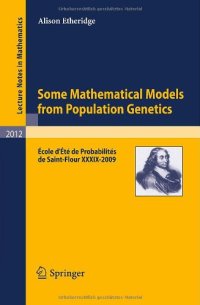
Ebook: Some Mathematical Models from Population Genetics: École d'Été de Probabilités de Saint-Flour XXXIX-2009
Author: Alison Etheridge (auth.)
- Tags: Genetics and Population Dynamics, Mathematical Biology in General, Mathematical Modeling and Industrial Mathematics, Partial Differential Equations, Statistics for Life Sciences Medicine Health Sciences
- Series: Lecture Notes in Mathematics 2012 École d'Été de Probabilités de Saint-Flour
- Year: 2011
- Publisher: Springer-Verlag Berlin Heidelberg
- Edition: 1
- Language: English
- pdf
This work reflects sixteen hours of lectures delivered by the author at the 2009 St Flour summer school in probability. It provides a rapid introduction to a range of mathematical models that have their origins in theoretical population genetics. The models fall into two classes: forwards in time models for the evolution of frequencies of different genetic types in a population; and backwards in time (coalescent) models that trace out the genealogical relationships between individuals in a sample from the population. Some, like the classical Wright-Fisher model, date right back to the origins of the subject. Others, like the multiple merger coalescents or the spatial Lambda-Fleming-Viot process are much more recent. All share a rich mathematical structure. Biological terms are explained, the models are carefully motivated and tools for their study are presented systematically.
This work reflects sixteen hours of lectures delivered by the author at the 2009 St Flour summer school in probability. It provides a rapid introduction to a range of mathematical models that have their origins in theoretical population genetics. The models fall into two classes: forwards in time models for the evolution of frequencies of different genetic types in a population; and backwards in time (coalescent) models that trace out the genealogical relationships between individuals in a sample from the population. Some, like the classical Wright-Fisher model, date right back to the origins of the subject. Others, like the multiple merger coalescents or the spatial Lambda-Fleming-Viot process are much more recent. All share a rich mathematical structure. Biological terms are explained, the models are carefully motivated and tools for their study are presented systematically.